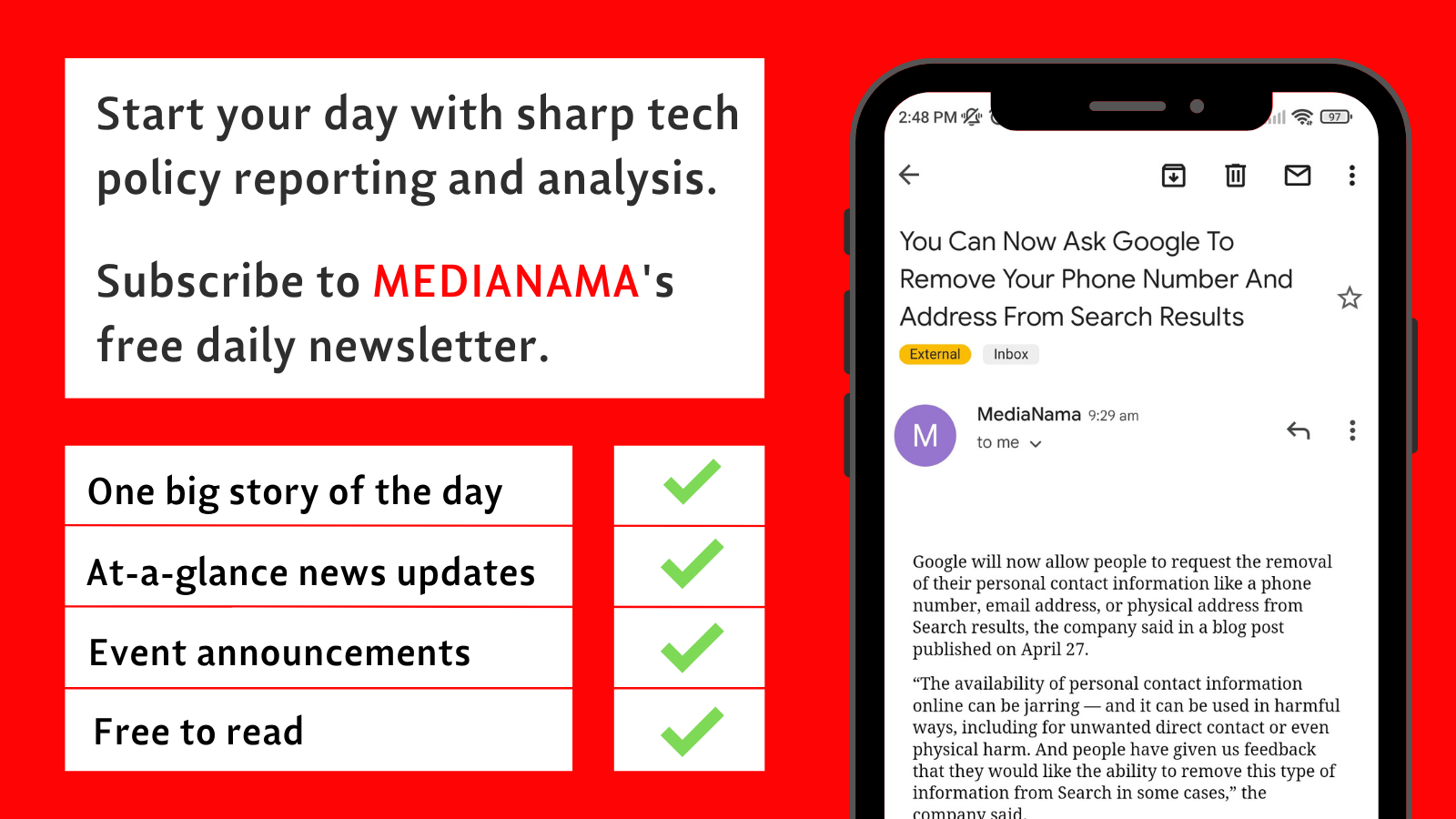You’ve seen the signs. You’ve read the hoardings. India is the President of the G20 for this year. If the 50 ads per square foot are anything to go by, this is something the government wants us to know about, and possibly, be proud of.
But, seriously, what exactly is the G20? Why does it matter? Should we care about it at all? Why are so many public ads on the summit cropping up everywhere? And, most importantly, what on earth does it have to do with tech policy?
In the first of this two-part series, we explain why the G20 matters—and how it inevitably ends up impacting tech policy too. We’ll cover India’s tech policy agenda at the summit in part two.
Bringing you up to speed
First thing’s first, what is the G20?: G20 is short for the Group of Twenty—comprising some of the world’s most powerful economies. That’s not an exaggeration: they represent “around 85% of the global GDP, over 75% of the global trade, and about two-thirds of the world population”.
An interesting aside noted by the Council on Foreign Relations: “these figures have remained relatively stable while the corresponding rates for Group of Seven (G7) nations, a smaller group of advanced democracies, have shrunk, as larger emerging markets take up a relatively greater share of the world’s economy”. Translation: grand old powers aren’t the only ones who have a stake in international politics anymore (if they ever were).
FREE READ of the day by MediaNama: Click here to sign-up for our free-read of the day newsletter delivered daily before 9 AM in your inbox.
But, what exactly does the G20 do?: Think of it like a year-long meeting, where all the members come together to figure out how to develop global frameworks on the world’s most pressing economic issues. G20 countries (try to) agree on adopting specific approaches that solve specific economic issues. Its objectives, among others, are:
- “Policy coordination between its members in order to achieve global economic stability, sustainable growth;
- Promoting financial regulations that reduce risks and prevent future financial crises;
- Modernizing international financial architecture”.
Why economic issues?: The G20 is a product of a financial crisis. It was formed way back in 1999 in the aftermath of the Asian financial crisis. The concern: “developing countries were insufficiently involved in discussions and decisions concerning global economic issues”. Finance ministers and central bank ministers of Canada, France, Germany, Italy, Japan, the United Kingdom and the United States came together to brainstorm on all things macroeconomic. In 2008, after the global economic crash, the G20 switched to inviting heads of state instead. In 2009, it was tagged as the “premier forum for international economic cooperation”.
But, MediaNama covers tech policy. Why talk about the G20?: Because there aren’t that many economic issues left that don’t involve technology. Technology is used to bank. Technology is used to fast-track economic growth. Technology is used to deliver public goods. Technology is used to bypass central banks (hello crypto). You simply can’t extricate one from the other—which is why the G20 inevitably focuses so much on technology, and why we’re covering it too.
So, economics isn’t all the G20 covers?: Nope. The forum now also focuses on other sectors typically discussed by international organisations. So you’ll see lots of different sessions on international frameworks for trade, climate change, health, environment, and anti-corruption happening too.
How does policy-making for all these issues work then?: There are essentially two broad tracks where policies are discussed at the G20: the Finance Track and the Sherpa Track.
- Finance Track: Think of this as sort of a G20 OG. Finance ministers and central bank governors lead the discussions here. From India’s end, the Finance Track is largely led by the Ministry of Finance.
- Sherpa Track: This track looks at issues like climate, development, health, and education, among others. It’s led by ‘sherpas’. Don’t confuse the term with the sherpa communities renowned for their mountaineering skills. Google tells us that a sherpa is also a “civil servant or diplomat who undertakes preparatory work prior to a summit conference”. The sherpas monitor the year-long negotiations and coordinate a lot of the G20’s work. India’s G20 sherpa is Amitabh Kant.
Working groups are set up within both tracks to focus on the thematic issues we discussed earlier. They’re staffed by ministry officials of G20 members, invited countries, and international organisations. Engagement groups also bring together think tanks, businesses, researchers, and civil society to discuss policy approaches to G20 issues.
And where does India come in?: This year, India is the President of the G20—which is why you’re seeing hundreds of ads in your city on the summit. That’s a pretty important position: it means that India is essentially shepherding the year’s agenda for one of the world’s most important groupings. Its motto for the year (in case you missed the ads) is “Vasudhaiva Kutumbakam – One Earth One Family One Future”. It’ll host 200-plus meetings across 50 cities on different G20 policy issues, as well as the final summit in New Delhi in September.
Why India’s role here might be worth keeping an eye on
Does anything worthwhile happen at these meetings?: You’re not wrong for wondering if international institutions actually get any work done amidst all the PR and national grandstanding—that’s a critique that’s been doing the rounds for decades. But, the G20 has actually done some interesting coalition-building in the past.
Remember the big crash?: Post the 2008 recession, G20 leaders came together to reform and clean up banks (that were largely responsible for the crisis in the first place). International banks increased the amounts countries could take out as loans to finance their economies. Central banks agreed to push interest rates to “rock bottom” to encourage spending and growth. Billions of dollars were pledged to finance international trade deals and kickstart the global economy. Some think these measures “rescued a global financial system in freefall during 2009-2010”. Others add that “macroeconomic coordination within the G20 played a key role in preventing the financial crisis of 2008 from descending into a second Great Depression”. A reminder: a lot of the success stories on the G20’s role in addressing the crisis read a little like good PR, barring this review by Australia’s central bank.
What about after 2008?: Researchers seem to think that after the crisis passed, G20 members couldn’t really get along as well. That was often because countries were divided over key policy issues—and naturally put their own interests first in negotiations. Leaders might have also been interested in just building their own one-to-one relationships with individual countries, instead of trying to find common ground with 19 others.
“It is probably more realistic to have relatively low expectations of either efficient decision-making or of successful substantive outcomes [at the G20], particularly once the white-heat of crisis had passed,” drily remark Suman Bery, Filippo Biondi, and Sybrand Bekelmans. “Policy coordination is intrinsically hard, yet a pure “my way” strategy is also untenable in a highly interconnected world, tempting though that might be for the economically powerful.”
Enter, India: India’s role at the forum could mark a different path—it wants to help countries find a middle ground at the forum. Hear it from the External Affairs Minister, S. Jaishankar himself:
“Today, the world is very polarised. Even having everybody in the room was a real challenge at the last G20 meeting in Bali. So, a country like India, which is independent minded… is respected to a great extent, is trusted, which has a kind of a middle ground to bring differing parties to the table… I think the value for countries in the middle, who are good at forging common ground, who have multiple relationships, I think that has grown in a polarised world and… the value of the Indian presidency will be demonstrated because we have that trait.”
Or, as Arindrajit Basu of the Centre for Internet and Society said at a MediaNama event last year:
“This [the G20 presidency] is also an opportunity for India to use evidence from domestic policy to shape the narrative on Internet governance. Not because India needs to create a fourth bloc [apart from the United States, China, and the European Union]—but because it is important for experiences from the world’s largest democracy to shape narratives on global policy issues.”
So, the G20 might be flawed—but it’s clearly not an unimportant forum for India to be leading. India has the chance to push for its own visions of global governance here, especially for tech policy. We explore these smoke signals in part two.
This post is released under a CC-BY-SA 4.0 license. Please feel free to republish on your site, with attribution and a link. Adaptation and rewriting, though allowed, should be true to the original.
Read More
- G20 Not The Right Forum To Discuss Global Cross Border Data Flows: Civil Society Orgs
- G20’S Engagement Group Calls For Abstracts On Tech Policy Briefs
- Ahead Of G20 Presidency, India Takes Over As Council Chair Of Artificial Intelligence Forum
- Indian Govt To Assemble Anonymised Non-Personal Data Sets: Minister At G20
































